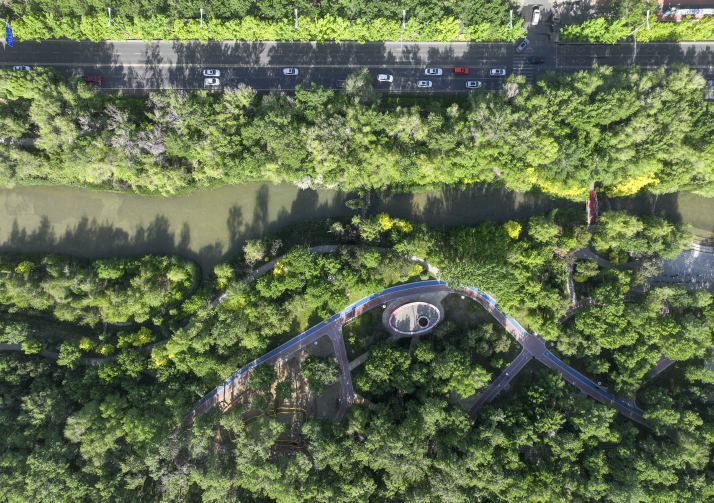| Xinjiang Today |
| Stories beyond the headlines | |
|
|
 Visitors sample grapes at a market in Turpan City on August 17, 2024 (XINHUA)
Xinjiang Today features reflections from international visitors, scholars and journalists who have seen the region with their own eyes. Their firsthand accounts offer personal perspectives that contrast sharply with negative external media narratives, revealing a Xinjiang marked by ethnic diversity, cultural vibrancy and a strong sense of community. Whether attending international forums, celebrating local festivals or simply walking through city streets, these voices share a collective story—one of discovery, connection and surprise.
Ezzeddine Abdelmoula, manager of research at the Al Jazeera Center for Studies in Qatar Before my first trip to Xinjiang, I held the impression many outside of China likely share: a distant, inaccessible region, closed to foreigners and shrouded in narratives from the Western media. Yet, stepping off the plane, these preconceived notions began to dissolve, replaced by vibrant realities on the ground. Last year, my initial visit took me through bustling Urumqi, scenic Ili and the lively trade zones bordering Kazakhstan. My second trip this April, attending the Shanghai Cooperation Organization (SCO) Political Parties Forum in Urumqi, further highlighted the region's remarkable cultural harmony, rapid economic growth and transformative infrastructural advancements. The most vivid image imprinted on my memory remains Xinjiang's astonishing diversity, people of various ethnicities and backgrounds coexisting, each contributing uniquely to a vibrant cultural tapestry. Xinjiang's richness isn't confined to culture alone; it also manifests clearly in its sophisticated infrastructure and booming economy. High-speed railways, advanced manufacturing hubs and impressive technological parks are not merely abstract symbols of development, but tangible realities shaping everyday life. Indeed, Xinjiang stands as a testament to China's commitment to bridging regional development gaps. When first invited to explore Xinjiang, skepticism tinged my anticipation. The Western portrayal of the region, often spotlighting unrest and tensions, contrasted starkly with what awaited me, a society visibly committed to unity and stability. China's policy of fostering unity and interconnectedness among ethnic groups, exemplified by President Xi Jinping's metaphor of people being "tightly bound together like pomegranate seeds," seems to be genuine and supported by tangible efforts. One notable illustration is Xinjiang's counter-terrorism approach, emphasizing social stability through inclusive economic growth rather than mere enforcement. Contrary to external narratives, Xinjiang today is not a region defined by conflict, but by palpable peace and thriving communities. To truly understand Xinjiang, one must see beyond headlines. It's easy to criticize from afar, harder to ignore when confronted by reality. My visits provided a critical balance against partial narratives and underscored the importance of firsthand experiences. With the opening of the north terminal at Urumqi Tianshan International Airport on April 17, Xinjiang is welcoming more foreign visitors to witness its evolving story firsthand. The picturesque lakes atop snow-capped mountains, bustling bazaars and the palpable warmth of diverse communities aren't just tourist attractions; they're avenues toward deeper understanding. I believe China should actively encourage even more international visitors, academics and journalists to see Xinjiang with their own eyes. Each encounter, like mine, offers a profound shift from suspicion to appreciation. Xinjiang isn't just a place worth visiting; it is a lesson in unity amid diversity, growth amid challenges and openness amid misunderstanding.  A drone photo shows the urban area of Shihezi City on May 15, 2024 (XINHUA)
Maryam Razzaq,senior reporter at The Daily Scrum News in Canada Arriving in Xinjiang for the first time, I carried with me not only curiosity but considerable apprehension, influenced heavily by alarming narratives prevalent in Western media. As both a Muslim and a journalist, reports of forced labor, cultural repression and persecution of Uygur Muslims in the Western media had cast a long shadow over my perception. Yet, from the moment I stepped onto Xinjiang soil, my expectations began unraveling, replaced instead by stunning landscapes, vibrant cultural diversity and an undeniable sense of unity. My initial exploration led me to a bustling bazaar in Urumqi, brimming with life and color. Vendors proudly showcased traditional Uygur crafts, and the air was filled with the enticing aromas of freshly ground spices. The warmth and openness of locals, from merchants patiently helping me choose a traditional Doppa hat to hotel staff eager to share their cultural heritage, was a stark contrast to the scenes of oppression I had imagined. The Eid celebrations, in particular, were eye-opening. Families dressed in vibrant attire gathered joyfully, exchanging greetings and laughter in their native tongues. Observing the relaxed atmosphere, where Uygurs openly expressed their cultural and religious identities, deeply challenged the narratives I'd encountered abroad. Instead of persecution, what I saw was celebration; instead of forced conformity, I witnessed cultural preservation and mutual respect. Throughout my journey, infrastructure and economic development stood out distinctly. The newly established Kashi (Kashgar) Economic Development Zone exemplified modernity blended harmoniously with historic preservation. Streets that Western media portrayed as tense or unsafe felt secure, vibrant and progressive, bustling even late into the night. Xinjiang's economic growth, particularly evident through partnerships with neighboring countries like Kazakhstan and Pakistan, spoke volumes about the region's promising future. Yet, more profound than the visible advancements was Xinjiang's approach to counter-terrorism and societal stability. Policies promoting economic inclusivity, education and cultural respect have fostered a climate of harmony rather than discord. Visiting the Xinjiang Islamic Institute and joining Eid prayers at a local mosque underscored an atmosphere of genuine religious freedom, profoundly challenging previous misconceptions. As someone of Pakistani heritage raised in Canada, I found familiarity in Xinjiang's culture, especially its cuisine. Pilaf fragrant with spices, reminiscent of home-cooked meals, underscored the human connection shared across cultures. These intimate encounters humanized a region that has often been misrepresented by external narratives. Reflecting on my visit, the seminar on cognitive warfare in journalism resonated deeply. It highlighted the destructive power of biased reporting and reinforced my conviction that true journalism demands firsthand experience. Western media narratives about Xinjiang, driven more by political agenda than factual observation, create unnecessary fears, particularly impacting tourism and economic development negatively. Now, planning a return visit with my mother, my goal is clear: to introduce others to the Xinjiang I encountered. This is not a land of strife and suppression but one rich in cultural diversity, economic potential and above all, authentic human connections. Seeing Xinjiang with one's own eyes reveals truths far beyond headlines, truths that speak eloquently of coexistence, prosperity and harmony. Abdullah Nuruddin, a Sudanese professor at the School of Foreign Languages of Shihezi University in Xinjiang My journey in China began in 2011, amid the towering skyscrapers and timeless temples of Beijing, a place where modernity harmoniously coexists with ancient traditions. For four enriching years, I pursued my doctoral studies, traveling from snowy northern cities to the humid coastal regions of the south. Although Xinjiang remained a distant aspiration, its landscapes frequently stirred my imagination—a place I longed to explore firsthand. Years later, in 2017, my return to China brought me closer to this dream. Living among Inner Mongolia Autonomous Region's herders, I embraced a tranquil nomadic lifestyle, riding horses across vast grasslands and savoring traditional milk tea. The profound peace of that experience intensified my yearning to finally set foot in Xinjiang. In 2019, when I finally arrived in Shihezi City in north Xinjiang, often called the "Bright Pearl in the Heart of Asia," I was captivated immediately. Shihezi welcomed me with wide, pristine streets, a vibrant cultural atmosphere and an extraordinary sense of community. Here, ethnic harmony is not an ideal but a daily reality, beautifully exemplified by nightly gatherings in the town square, where diverse groups dance, sing and celebrate together in a living symphony of unity. Each teaching break allowed me to discover Xinjiang's astounding beauty, which unfolded anew with every changing season. Spring painted landscapes in vibrant blossoms, while summer showcased endless grasslands reaching toward the horizon. Autumn brought serenity through lakes mirrored by majestic mountains and winter blanketed the land in pristine snow. Xinjiang's natural splendor was more magnificent than I had ever imagined, fulfilling years of longing. Yet, beyond scenic beauty, Xinjiang's true allure lies in the warmth and generosity of its people. My neighbors, who regularly invited me for tea and shared stories of their proud heritage, made me feel like family. Meals of freshly baked naan bread and succulent roasted mutton conjured nostalgic memories of my grandmother's kitchen, further cementing my emotional connection to this place. One unforgettable evening, lost in Shihezi's older neighborhoods as dusk descended, a kind elderly man noticed my confusion. He insisted on guiding me personally to my destination, warmly remarking, "Here, we believe guests are gifts from heaven." At that moment, I felt not only guided but deeply embraced, a foreigner yet very much at home. Shihezi became more than just a place I stayed; it transformed into my home away from home. Here, daily life unfolds in beautifully ordinary ways: children laughing in squares, shopkeepers exchanging friendly greetings, neighbors sharing smiles of recognition. These simple interactions formed the fabric of my most treasured memories. As I sit in a cozy Shihezi restaurant, surrounded by sizzling kebabs and friends from various backgrounds, our laughter transcends language. I realize the real charm of Xinjiang lies in these heartfelt human connections. If someone asks why Xinjiang is extraordinary, my answer is simple yet profound: "Every meal feels like a festival, every day a celebration and every person a poem." Comments to zhaowei@cicgamericas.com |
|
||||||||||||||||||||||||||||
|